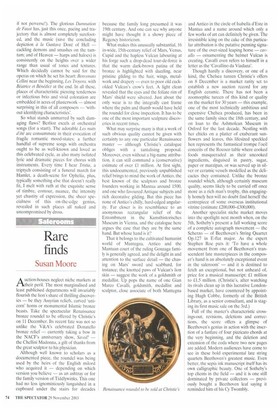Rare finds
Susan Moore
A uction-houses neglect niche markets at
their peril. The most marginalised and least publicised departments will invariably flourish the lion's share of thrilling discoveries — be they Assyrian reliefs, carved 'unicorn' horns or monumental Islamic bronze beasts. Take the spectacular Renaissance bronze roundel to be offered by Christie's on 11 December. Its recent fate was not so unlike the V&A's celebrated Donatello bronze relief — currently taking a bow in the NACF's anniversary show, Saved! — the Chellini Madonna, a gift of thanks from the great sculptor to his physician.
Although well known to scholars as a documented piece, the roundel was being used by the heirs of the English milord who acquired it — depending on which version you believe — as an ashtray or for the family version of Tiddlywinks. This one had no less ignominiously languished in a cupboard under the stairs for decades
because the family long presumed it was 19th century. And one can see why anyone might have thought it a showy piece of Regency historicism.
What makes this unusually substantial, 16 in-wide, 15th-century relief of Mars, Venus, Cupid and the hapless Vulcan labouring at his forge such a drop-dead tour-de-force is that the warm dark-brown patina of the bronze is highlighted with da77ling, near pristine gilding to the hair, wings, metalwork and drapery — even to poor old cuckolded Vulcan's crow's feet. A light clean revealed that the eyes and the foliate rim of Mars' shield were silvered. Just about the only wear is to the integrally cast frame where the palm and thumb would have held the roundel for close inspection. It has to be one of the most important sculpture discoveries in recent times.
What may surprise many is that a work of such obvious quality cannot be given with certainty to any one particular Renaissance master — although Christie's catalogue obliges with a tantalising proposal. Moreover, even without a big-name attribution, it can still command a (conservative) estimate of over 1 million. At first sight, this undocumented, previously unpublished relief brings to mind the work of Antico, the best known of the sculptors and bronze founders working in Mantua around 1500, and one who favoured Antique subjects and rich decorative gilding. But this piece has none of Antico's chilly, hard-edged angularity. Far closer is its resemblance to an anonymous rectangular relief of the Entombment in the Kunsthistorisches Museum in Vienna, and the catalogue here argues the case that they are by the same hand. But whose hand is it?
That it belongs to the cultivated humanist world of Mantegna, Antico and the Mantuan court of the ruling Gonzaga family is generally agreed, and the delight in and attention to the surface detail — the chasing on Mars' sword and scabbard, for instance; the knotted paws of Vulcan's lion skin — suggest the work of a goldsmith or medallist. Up pops the name of one Gian Marco Cavalli, goldsmith, medallist and sculptor, close associate of both Mantegna
and Antico in the circle of Isabella d'Este in Mantua and a name around which only a few works of art can definitely be given. The irresistible icing on the cake of this particular attribution is the putative punning signature of the over-sized leaping horse — cavallo — ornamenting the helmet Vulcan is creating. Cavalli even refers to himself in a letter as the `Cavallino da Viadana'.
Though hardly a discovery, or one of a kind, the Chelsea tureen Christie's offers on 8 December is a market rarity set to establish a new auction record for any English ceramic. There has not been a zoomorphic tureen of this kind or quality on the market for 30 years — this example, one of the most technically ambitious and expensive Chelsea produced, has been in the same family since the 18th century, and on loan to the Ashmolean Museum in Oxford for the last decade. Nestling with her chicks on a platter of exuberant sunflowers and leaves, this lifesized speckled hen represents the fantastical trompe l'oeil conceits of the Rococo table where cooked foods masqueraded as their uncooked ingredients, disguised in pastry, sugar, paper or marzipan, or was served up in silver or ceramic vessels modelled as the delicacies they contained. Unlike the bronze roundel which, although certainly museum quality, seems likely to be carried off once more as a rich man's trophy, this engagingly homely hen will no doubt find herself the centrepiece of some overseas institutional vitrine (estimate £200,0004300,000).
Another specialist niche market moves into the spotlight next month when, on the 5th, Sotheby's present a full working score of a complete autograph movement — the Scherzo — of Beethoven's String Quartet Op.127 in E-flat major. As the expert Stephen Roe puts it: To have a whole movement from one of Beethoven's transcendent late masterpieces in the composer's hand is an absolutely exceptional event in the saleroom' — and it is destined to fetch an exceptional, but not unheard of, price for a musical manuscript: £1 million to £1.5 million. (Christie's, after watching its rivals clean up in this lucrative Londonbased market, have countered by appointing Hugh Cobbe, formerly of the British Library, as a senior consultant, and is staging its first music sale on the 3rd.) Full of the master's characteristic crossings-out, revisions, deletions and corrections, the score offers a glimpse of Beethoven's genius in action with the insertion of a fanfare of four pizzicato chords at the very beginning, and the deletion and extension of the coda where two new pages are added. Modern audiences have come to see in these bold experimental late string quartets Beethoven's greatest music, Even better, the sepia ink manuscript itself has its own calligraphic beauty. One of Sotheby's top clients in the field — and it is one still dominated by private collectors — previously bought a Beethoven leaf saying it reminded him of his Cy Twombly.


























































































 Previous page
Previous page